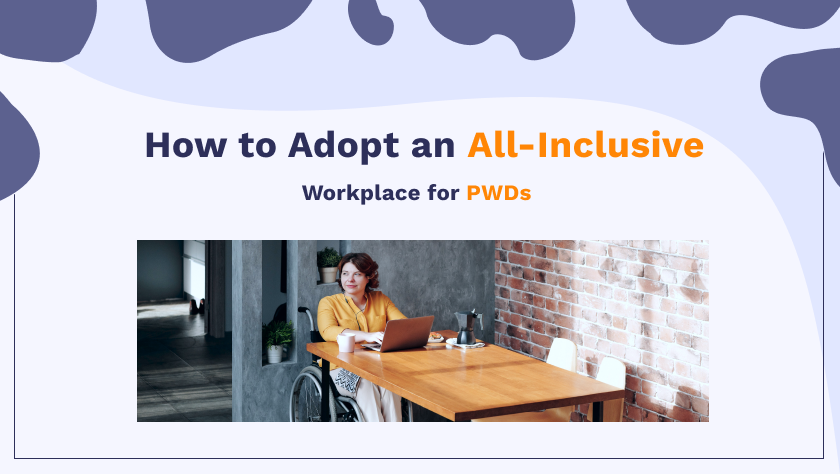Does one’s disability prove to be a hindrance in the workplace and for a successful career? PWDs face obstacles upon entering the workforce. In Australia alone, there are 4.4 million adults that live with some sort of disability, but only 53% are employed.
About 80% to 90% of the world’s PWD population is unemployed. Businesses missed the opportunity to tap these talent pools for their unique contributions to the workplace culture.
Internal inclusivity and concerns of PWDs in the workplace
In a study made by Accenture, organizations that include disabled workers have twice the capacity for higher returns on investment. Even so, workers with disabilities can perform their duties at work and overall industry just as well as their counterparts without disabilities.
For that to happen, managers and top-level executives must acknowledge that inclusivity is a company concern and not just HR to drop and handle. Employers, too, have misconceptions about PWDs that hinder employment opportunities.
Common misconceptions and their truths include:
- Physical and mental cases. Disability does not limit itself to visible cases such as severe physical and mental disabilities
- Different kinds of disabilities. Disabilities can also be in the form of fatigue, learning abilities, post-traumatic disorders, etc.
- Impact performance. Disabilities won’t prevent them from completing work and company tasks.
These conceptions serve as obstacles to hiring PWDs because employers are worried that their investment won’t make up the returns of the company. They are also wary of insurance and special costs to invest in while PWDs get to have missed workdays.
Because of society’s perception of disabilities, PWDs themselves found it hard to handle their core concerns.
- Low self-esteem
- Limited inclusiveness and belongingness in a community
- Feeling inferior or hindrance to others
PWDs need a sense of belongingness through empathy – not sympathy. What firms and employers can offer are activities, equal opportunities, amenities, and technologies to empower their employees with disabilities.
Barriers to employment opportunities
Factors such as personal biases, appropriate equipment, or training, serve as barriers to employment opportunities. This creates tension critical to a productive and healthy workplace for PWDs.
Company culture
The company may lack proper training and etiquette in handling PWD concerns. For example, the term PWD is more effective than saying ‘handicapped.’ Instead of feeling sympathetic, companies can assist them through training and workshops, for PWDs to be empowered and accountable.
Technological and transportation barriers
Does the company lack equipment, facilities, and transportation tools to help PWDs get to work effectively? For an example of these barriers are:
- Wheelchair access
- The ability of the disabled individual to work ground floor instead of going upstairs
- The flexibility of employment for a work at home opportunity
- Parking spaces near the office
- Doors and entrances easy to walk-in
Communication barriers
Inclusive communication and materials needed at work may be a hindrance to PWDs who have a hard time reading, speaking, or writing. E.g. a company manual for PWDs to understand the work on hand. Other than that, why not offer assistive technologies like Braille systems and sign language translator prints?
How to adopt an all-inclusive workplace for PWDs
Disabled individuals have as much right to have a stable job then we do. The UN’s Convention on the Rights of Persons with Disabilities, states that industries should recognize the right of PWDs for employment opportunities on an equal basis with others.
Also, the workplace should be inclusive and accessible to persons with disabilities. If you’re a business owner planning to adopt policies for PWDs in the workplace, here’s how to make the workplace more inclusive.
Be proactive online when hiring PWDs in the workplace
If you want to be inclusive in the workplace, you can start by hiring people online. Hiring accessibility makes it easier for PWDs to apply for a job. According to Practical E-commerce, 54% of disabled persons apply online on job listing sites and direct company websites.
- Actively share that your company is hiring PWDs
- Set guidelines such as the scope of work, accountability, employment opportunities, and benefits once they’re hired
- Ask what they need and offer what you can give back such as technology aids, training, and company outreach
Analyze company culture and policies
If you want your workplace to be more inclusive and accessible, start by changing the culture and policy framework of the firm. These changes will reflect on your day-to-day operations on how employees see PWD coworkers.
- Learn disability etiquette
- Avoid using negative connotations
- Continuous training and workshop on diversity and PWD inclusivity
- Appropriate actions for harassment and discrimination
- Applicable support systems for PWDs
Invest in assistive technology
Assistive technologies like the Braille system, sign language apps, speech recognition apps, hearing aids and devices, etc. can help make the workplace easy for PWDs. When your employees have access to assistive tools, their job allows them to carry work without any issues.
Other assistive technologies in the office include:
- Accessible washrooms
- Dimmers for light-sensitive people or noise-cancellation audio system
- Height-adjustable chairs
Change physical barriers
Removing physical barriers allows inclusivity and accessibility in the workplace. For instance, wheelchair ramps, easy entrance doors, or parking spaces reserved for PWDs can help people with mobility issues. You can even provide easy resources and access to materials online so your employees don’t have to go to the office.
Consider support from the government and NGOs
Government and advocacy programs are catering to PWDs in the workplace. You get to share resources, provisions, training, and assistive technology to make the workplace inclusive for disabled persons. Support from third-party agencies also ensures and certifies your business for safe work, currently up to date, and PWD-friendly. If you’re an employer, evaluate your firm’s inclusivity process and internal policies. It’s not enough to just hire people with disabilities. It’s important that these individuals feel that they belong in an organization with equal opportunities and employment rewards just like anyone else.





